How do Electronic Expansion Valves work? In this article we’ll be discussing how electronic expansion valves work, covering the basic working principle, where to locate them in a refrigeration system and why you should use them. This covers a simplified version to help you learn HVAC basics.
Scroll to the bottom to watch the YouTube tutorial
Check out these real world Electronic Expansion Valves, full technical information and illustrations! click here
All HVAC/R systems can benefit from the most comprehensive series of electronic expansion valves on the market. The Danfoss portfolio makes it possible to keep up with increasing environmental concerns and tighter CO2 emission regulations, while enabling significant energy savings and cost reductions.
Learn more here – http://bit.ly/Electronic_expansion_valves
Electronic Expansion valves are used in refrigeration systems to precisely control the flow of refrigerant into the evaporator. You can find these on everything including
- VRF units
- Inverter mini splits
- Heat pumps
- Chillers
- AHU coils
Etc.
We previously covered how thermal expansion valves work, these are very common in refrigeration systems but they are no where near as efficient or precise as an electronic expansion valve. If you haven’t watched the video on how these work then I highly recommend you do by clicking here
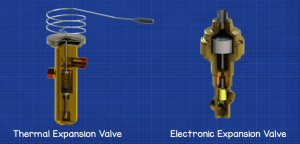
Electronic expansion valves are an evolution on the thermal expansion valve. They are much more sophisticated and allow the refrigeration system to operate much more accurately and efficiently. You’ll usually see electronic expansion valves listed with the acronym of either EEV or EXV. They both mean the same thing it just varies by manufacturer.
Benefits of using an electronic expansion valve
There are many benefits to using an electronic expansion valve and I’ve listed some of the main ones on screen now. The focus though is usually that by using these expansion valves you’re going to reduce energy consumption from the refrigeration system and well as gaining better performance.
- Precise control
- Fast and accurate response to load change
- Wider part load variation than TXV
- Maintains maximum capacity control even at part loads
- Injects exactly the right amount of refrigerant
- Energy savings ~15%
What do electronic expansion valves look like?
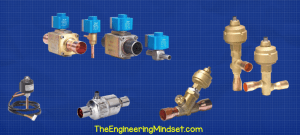
There are many different designs for electronic expansion valves, I’ve put a few examples up on screen now so you can see how their appearance varies. The difference in design depends on the type of system, the refrigerant used and the pressures its working with. As you can imagine a small split ac unit isn’t going to need the same valve as a high pressure industrial application so the design is going to be different, although the basic working principle is essentially the same.
Main parts of an electronic expansion valve
As we just saw there are many different designs for electronic expansion valves. We’re going to focus on a simplified design to build your base knowledge. This design uses a Permanent Magnet stepper motor. At the head of the valve we have the stepper motor body which contains the copper coils, these are used to generate an electromagnetic field which will be used to control the valve position.
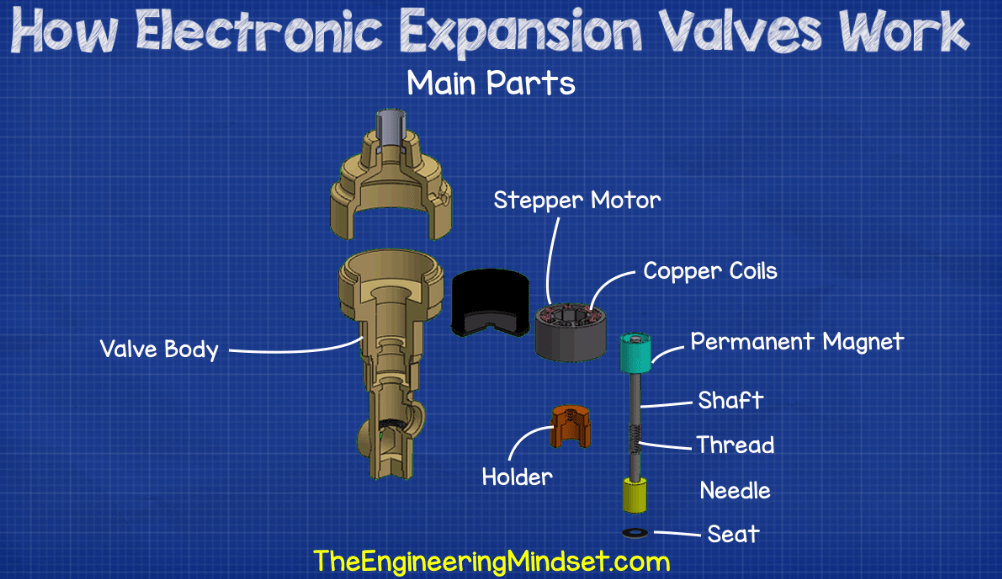
Sitting concentrically within the main body of the stepper motor is a permanent magnet. This permanent magnet is affected by the electromagnetic field of the coils and the change in polarity of the electromagnetic field will cause the permanent magnet to rotate.
Attached to the permanent magnet is a shaft. Some designs will use a gear assembly between the motor and the shaft instead but as we’re only looking at a simple design we’ll stick with a directly coupled shaft.
On the shaft is a thread, this thread sits within a holder which is attahed to the valve body. At the end of the shaft is the valve needle. Then we have the valve seat which the needle moves into and out of to close and open the valve. And control the flow of refrigerant.
We’ll also have some temperature and pressure sensors to take measurements of the refrigerant in order to calculate the superheat. And these will be connected to a controller. The controller is then connected to the stepper motor and will tell it how much to open or close.
How do electronic expansion valves work
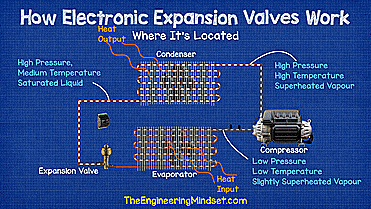
If we have a look at a refrigeration system, you can see the main parts being the evaporator, the compressor, the condenser and the expansion valve. The evaporator collects all the unwanted heat from the building and transfers this into the refrigerant which causes the refrigerant to boil and evaporate.
The compressor sucks in this evaporated refrigerant which is a low Pressure, low Temperature slightly superheated vapour, and then compresses this into a smaller volume which causes it to be a high pressure, high temperature superheated vapour.
The refrigerant then moves to the condenser where the unwanted heat is pulled out of the refrigerant and rejected into the atmosphere. This causes the refrigerant to condense into a liquid so when it leaves the condenser it will be a high pressure, medium temperature saturated liquid. It then passes down to the expansion valve.
The expansion valve causes a pressure difference between the condenser and the evaporator, it holds back the high-pressure liquid refrigerant and decides how much to let through into the evaporator.
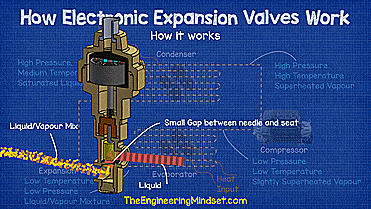
As the high pressure liquid refrigerant bursts through the small gap between the valve seat and the needle, it drops in pressure, this will result in some of the refrigerant vaporising and the rest will continue through as a liquid.
If you want to visualise it, it’s similar to a water bottle spray nozzle, as you pull the trigger the high pressure liquid is forced through a small orifice into a much lower pressure atmosphere which causes the water to become part liquid and part vapour.
This mixture of liquid vapour refrigerant is sprayed into the evaporator where it will absorb heat from the air or water which surrounds the outside of the pipe which forms the evaporator coil, in this case a fan is blowing air across the evaporator coil.
As the refrigerant passes through the evaporator coil it is exposed to thermal energy which will causes it to undergo a complete phase change from a liquid to a saturated vapour, still at a low pressure and temperature. During this change there will be little to no temperature change because of the latent heat and instead it will increase in entropy and enthalpy. As thermal energy is still being applied to the vapour towards the exit of the evaporator, there is no liquid left to change over into a gas so the refrigerant will increase in temperature and become superheated.
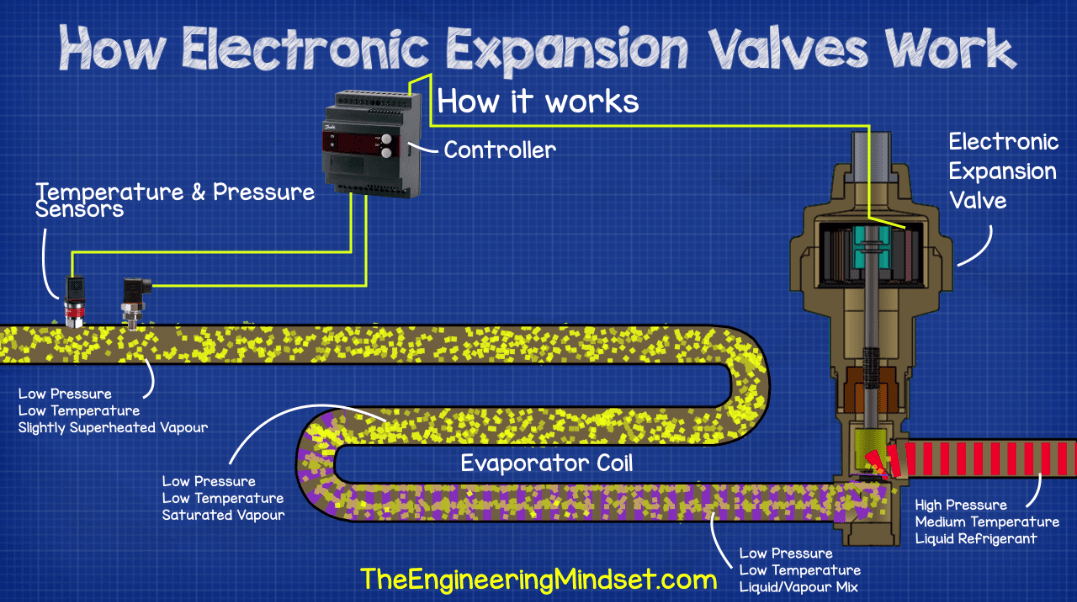
After the evaporator we’ll find a pressure transducer and a temperature sensor which constantly take measurements and sends this data to the controller. Not all electronic expansion valves will use this method, it depends on the manufacturer and system, some simple ones will use a single thermistor at the evaporator outlet, some will use two thermistors one at the inlet and another at the outlet and then use the temperature differential as the superheat, but were going to focus on the pressure and temperature method in this example as it’s a very reliable method and one you’ll likely come across in the real world.
The pressure is measured and converted by the controller, using stored data for the refrigerant being used in the system to find the saturation temperature, this is then compared to the actual temperature measurement, the difference between the two is the operating superheat. The controller then decides whether the expansion valve should open to let more refrigerant into the evaporator or close to reduce the amount entering.
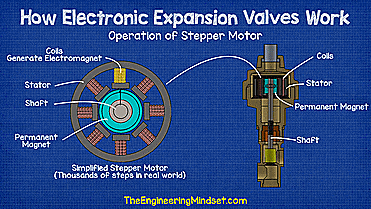
Once decided, the controller then sends electrical signals to the expansion valves stepper motor to energise the coils and create an electromagnetic field and vary its polarity, this forces the permanent magnet to rotate clockwise or counter clockwise depending on the polarity generated. Each time a signal is sent, the permanent magnet will rotate a fraction of a revolution to provide very accurate adjustments to the superheat.
The shaft which is connected to the permanent magnet will also rotate and as it does so, the threaded section inside the holder will cause the assembly to be pulled down. As the assembly is pulled down it will cause the valve needle to reach the seat, reducing the gap between and restricting the flow of refrigerant.
When the signal is sent to open the valve, the assembly will rotate in the opposite direction and the threaded section pulls the assembly up, this opens the valve and moves the needle away from the seat allowing more refrigerant to flow. The controller is constantly taking pressure and temperature measurements and sending signals to adjust the valve position to suit the load.
When the cooling load increases the refrigerant within the evaporator is going to boil off much quicker and the suction line pressure and temperature increases, the expansion valve senses this and opens to allow more refrigerant in.
When the cooling load decreases the refrigerant will boil off more slowly and the suction line pressure and temperature decreases, the expansion valve will begin to close to allow less refrigerant into the evaporator and maintain the correct superheat.

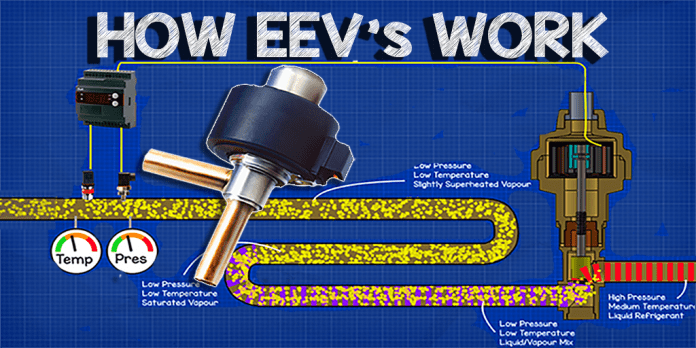
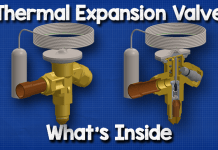
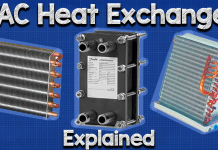
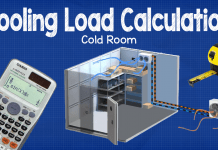

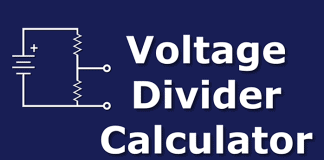
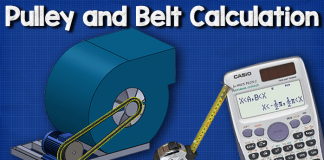
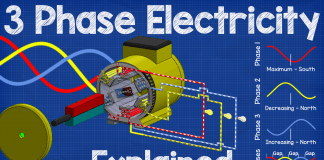
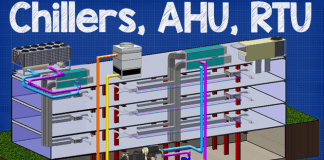
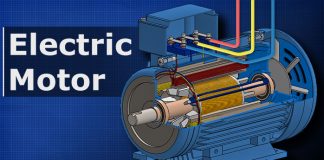








[…] In commercial refrigeration systems we’re almost certainly going to find at least one solenoid valve in the system and it’s usually found in the liquid line, near the expansion valve. We’ve also covered how expansion valves work previously, check that out by clicking here. […]
[…] have previously covered, in great detail, how thermal expansion valves and electronic expansion valves work as well as the different types of expansion valves used in […]
Hello! Kindly help with an AC -Smasung that is tripping off on cooling mode and operating normally on heating mode. Outdoor Sensors have been changed and problem has persisted. It uses EEV
Thanks for suggesting this. These will helps to use the expansion valves in vrf system too. Valves are used in vrf systems so helps in energy.
Hi Paul. I am an energy engineer and my task is to calculate the energy savings from installing an electronic expansion valve. Would you be so kind as to point me in the direction of where I might find information in regards to calculating savings? Thank you.
First, I can’t say thanks enough for the great education and content you are pumping out! Great work man.
I do have a question on the flow diagram for a heat pump system with a bi-directional EEX like this one:
https://www.danfoss.com/en-us/products/valves/dcs/electric-expansion-valves/ets-electric-expansion-valves/#tab-overview
I am assuming the by passes are gone, and there is now only one valve. Do I need two sets of temp and pressure sensors (for both flow patterns), if so how does the super heat controller sync communication to entire system to know about reversing valve position…
Thanks Again.
Mike
what is the difference between linear expansion valve and electronic expansion valve mechanism?